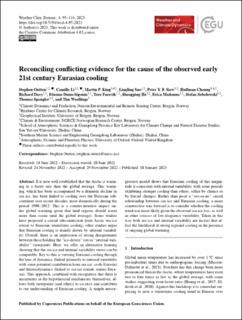| dc.contributor.author | Outten, Stephen | |
| dc.contributor.author | Li, Camille | |
| dc.contributor.author | King, Martin Peter | |
| dc.contributor.author | Suo, Lingling | |
| dc.contributor.author | Siew, Yu Feng | |
| dc.contributor.author | Cheung, Hoffman | |
| dc.contributor.author | Davy, Richard | |
| dc.contributor.author | Dunn-Sigouin, Etienne | |
| dc.contributor.author | Furevik, Tore | |
| dc.contributor.author | He, Shengping | |
| dc.contributor.author | Madonna, Erica | |
| dc.contributor.author | Sobolowski, Stefan Pieter | |
| dc.contributor.author | Spengler, Thomas | |
| dc.contributor.author | Woollings, Tim | |
| dc.date.accessioned | 2023-02-27T14:26:09Z | |
| dc.date.available | 2023-02-27T14:26:09Z | |
| dc.date.created | 2023-01-25T16:42:15Z | |
| dc.date.issued | 2023 | |
| dc.identifier.issn | 2698-4016 | |
| dc.identifier.uri | https://hdl.handle.net/11250/3054361 | |
| dc.description.abstract | It is now well established that the Arctic is warming at a faster rate than the global average. This warming, which has been accompanied by a dramatic decline in sea ice, has been linked to cooling over the Eurasian subcontinent over recent decades, most dramatically during the period 1998–2012. This is a counter-intuitive impact under global warming given that land regions should warm more than ocean (and the global average). Some studies have proposed a causal teleconnection from Arctic sea-ice retreat to Eurasian wintertime cooling; other studies argue that Eurasian cooling is mainly driven by internal variability. Overall, there is an impression of strong disagreement between those holding the “ice-driven” versus “internal variability” viewpoints. Here, we offer an alternative framing showing that the sea ice and internal variability views can be compatible. Key to this is viewing Eurasian cooling through the lens of dynamics (linked primarily to internal variability with some potential contribution from sea ice; cools Eurasia) and thermodynamics (linked to sea-ice retreat; warms Eurasia). This approach, combined with recognition that there is uncertainty in the hypothesized mechanisms themselves, allows both viewpoints (and others) to co-exist and contribute to our understanding of Eurasian cooling. A simple autoregressive model shows that Eurasian cooling of this magnitude is consistent with internal variability, with some periods exhibiting stronger cooling than others, either by chance or by forced changes. Rather than posit a “yes-or-no” causal relationship between sea ice and Eurasian cooling, a more constructive way forward is to consider whether the cooling trend was more likely given the observed sea-ice loss, as well as other sources of low-frequency variability. Taken in this way both sea ice and internal variability are factors that affect the likelihood of strong regional cooling in the presence of ongoing global warming. | en_US |
| dc.language.iso | eng | en_US |
| dc.publisher | Copernicus Publications | en_US |
| dc.rights | Navngivelse 4.0 Internasjonal | * |
| dc.rights.uri | http://creativecommons.org/licenses/by/4.0/deed.no | * |
| dc.title | Reconciling conflicting evidence for the cause of the observed early 21st century Eurasian cooling | en_US |
| dc.type | Journal article | en_US |
| dc.type | Peer reviewed | en_US |
| dc.description.version | publishedVersion | en_US |
| dc.rights.holder | Copyright 2023 The Author(s) | en_US |
| cristin.ispublished | true | |
| cristin.fulltext | original | |
| cristin.qualitycode | 1 | |
| dc.identifier.doi | 10.5194/wcd-4-95-2023 | |
| dc.identifier.cristin | 2114992 | |
| dc.source.journal | Weather and Climate Dynamics (WCD) | en_US |
| dc.source.pagenumber | 95-114 | en_US |
| dc.identifier.citation | Weather and Climate Dynamics (WCD). 2023, 4, 95-114. | en_US |
| dc.source.volume | 4 | en_US |

